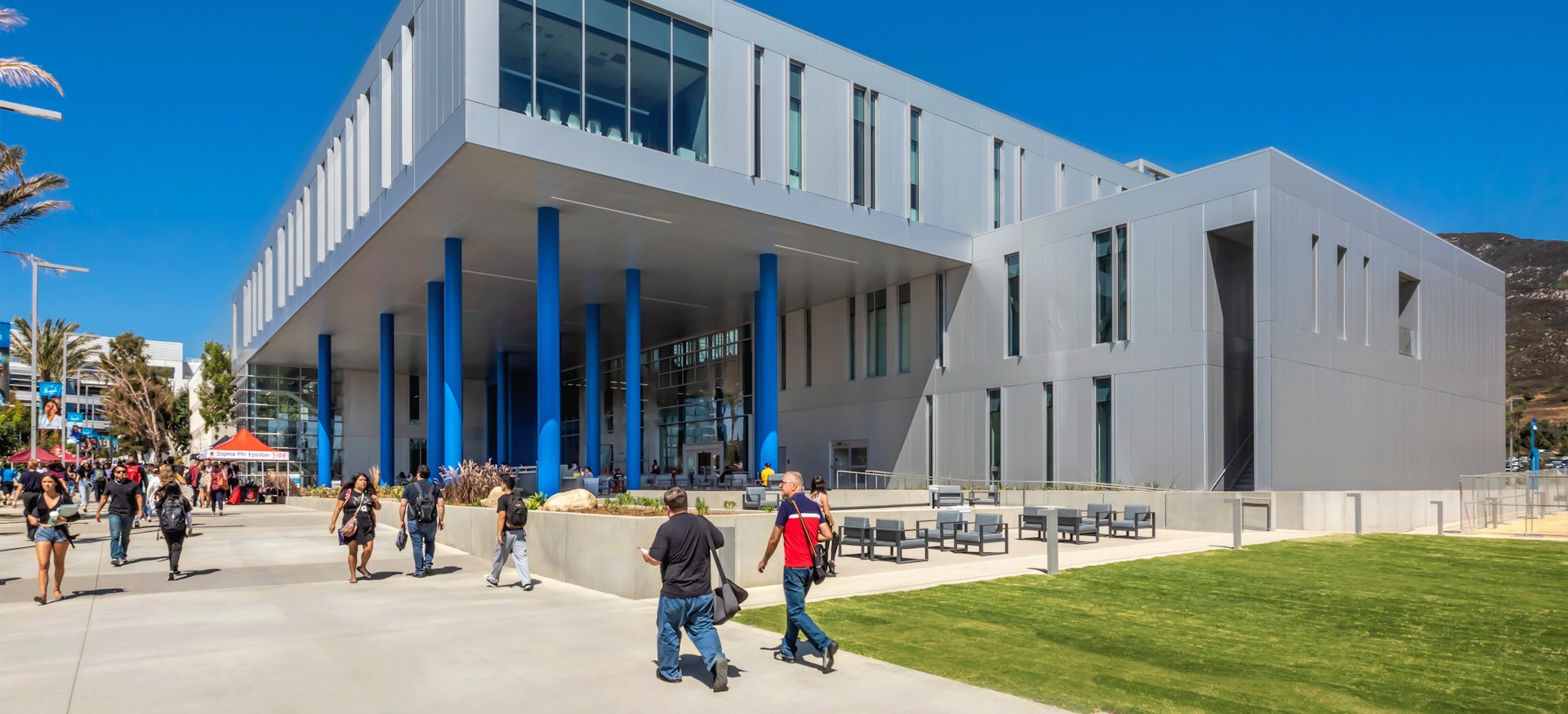In honor of Earth Day, the AIA California asked us to share examples of our projects that cut fossil fuel use and achieve climate change goals. AIA California recently recognized LPA with the 2021 Firm of the Year award, in large part, for our nation-leading work on building performance and our unique integrated culture. LPA was the largest firm in the country to meet the AIA 2030 Commitment energy reduction targets the past two years and last year earned a national AIA COTE Top 10 Plus award for the Environmental Nature Center and Preschool in Newport Beach, California.
In response to the AIA-California query, we present five of our nine LEED Platinum-certified projects. Each represents an example of how an integrated, collaborative design process produced measurable results.
Five Buildings that Perform Better for the Environment

CSU San Bernardino Global Innovation
San Bernardino, California
The three-story California State University, San Bernardino Center for Global Innovation, conceived as a “global gallery” reflecting the university’s large international student population, achieved LEED Platinum and surpassed Title 24 by 26.8 percent. Self-shading overhangs, access to natural daylight and an Energy Star cool roof help reduce energy consumption, while a 160kw photovoltaic array offsets 50 percent of the building’s energy use. One hundred percent of stormwater is collected and polished via bioswales.

LPA Irvine Studio / San Antonio Studio
Irvine, California / San Antonio, Texas
As part of its “walk the walk” philosophy, all of LPA’s six studios in California and Texas are either LEED Platinum or LEED Gold. The Irvine headquarters is designed as “living laboratory” of workplace and sustainable design. Efficiencies were found through lighting controls and fixtures; high-volume, low-velocity fans; and water fixtures that operate 40 percent better than the LEED baseline. A rooftop 70-kilowatt photovoltaic system offsets 20 percent of the office’s energy use
In San Antonio, a long-vacant retail space in San Antonio was redeveloped into a modern, energy- efficient workplace that boosts a revitalized neighborhood. The 10,300-square-foot studio features a 63.7-kilowatt photovoltaic (PV) system, which includes a solar canopy over parking stalls, as well as 100 percent LED lighting fixtures with controls, energy monitoring and low-impact site development techniques.

Environmental Nature Center and Preschool
Newport Beach, California
The original 9,000-square-foot ENC, completed in 2008, was certified as the first LEED Platinum building in the region and has operated at net zero since it opened. The net zero, 10,380-square-foot ENC Preschool was added in 2019, delivering nature-based education for children ages 2½ to 5 with a variety of indoor-outdoor play and education areas.
Developed through a holistic design approach, using the firm’s integrated team of architects, engineers, landscape architects, and interior designers, the buildings are oriented to allow for natural ventilation, significantly reducing initial and long-term costs. Neither building uses a mechanical cooling system. Low-energy ceiling fans and the building form enhance air movement when needed. Radiant floor heating provides low-energy, mild heating as required. The south-facing roof of the preschool accommodates a 32 kW array of photovoltaic panels, designed to provide 105 percent of the net energy for the preschool’s electrical needs

Edwards Lifesciences Starr Atrium
Irvine, California
The LEED Platinum, 25,000-square-foot Starr Atrium for Edwards Lifesciences, an industry-leading medical device manufacturer, created a bridge between two existing office buildings, as well as a dramatic new entry to the corporate headquarters.
LPA’s architects and engineers designed a unique ”truss net” structural system that spans the space and maximizes its openness and filters the light streaming through the skylight. Floor-to-ceiling windows provide a connection to the outdoors, while a bi-fold vertical lift door can be opened to promote natural ventilation. The atrium operates at net zero, with a photovoltaic array that fully offsets the energy used by the space. The atrium also includes a displacement ventilation system and LED lighting with controls. Sustainably sourced materials are used throughout the project, and the surrounding landscaped area incorporates bioretention planter areas to clean and conserve stormwater runoff.

Montgomery Middle School
Otay Mesa, California
The revitalized Montgomery Middle School is built on an east-west axis to maximize daylighting, minimize heat gain and allow for natural ventilation. An innovative HVAC system installed in two-story mechanical distribution hubs frees roof space for a future 217-kilowatt photovoltaic (PV) system. A thermal displacement ventilation system gently delivers air at a low level to condition classrooms. The roof form wraps the south façade to minimize solar heat gain, while maximizing daylighting and views. The angled roof plane also sends stormwater to bioswales, where it is filtered and cleansed before being absorbed into the ground.
A post-occupancy evaluation fine-tuned the design, helping educators take better advantage of operable windows, daylighting and temperature controls. “We’re saving money, we’re saving resources, we’re saving our planet,” said one board member after the school opened. “And at the same time, we’re providing the best quality education for our students.”














